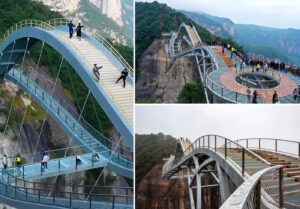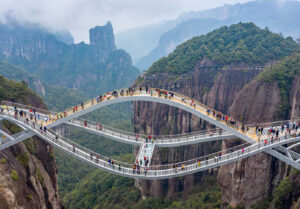Balancing engineering innovation & environmental protection: Lessons from Ruyi Bridge, China
Ruyi Bridge is an impressive cable-stayed bridge that spans over the Jinsha River in China.
27th of March 2023

Beijing, China: Ruyi Bridge is an impressive cable-stayed bridge that spans over the Jinsha River in China. The bridge connects the cities of Liuku and Pianma and is located in Yunnan province of the country. The bridge is a masterpiece of modern engineering that showcases the ingenuity of engineers and their ability to build magnificent infrastructure. In this article, we will explore the mechanism of the Ruyi Bridge and how it was constructed.

Background:
The construction of the Ruyi Bridge started in the year 2014 and was completed after two years, in 2016. The bridge is part of the G56 Hangzhou-Ruili Expressway, which connects Hangzhou in the east to Ruili in the west. The bridge is 1,430 m long, and the main span is 720 m long. The bridge has a total of 128 cables that support the deck, and the height of the main tower is 223 meters. The bridge has a total of six lanes and can accommodate both cars and trucks.
Although the Ruyi Bridge was primarily designed and constructed by a team of Chinese engineers and construction workers, the lead architect behind the project was He Weiming. He is a renowned bridge designer and professor at Tongji University in Shanghai. He has been involved in the design and construction of several prominent bridges in China, including the Chongqing Yangtze River Bridge and the Nanjing Yangtze River Bridge. He won numerous awards for his contributions to bridge engineering, including the National Science and Technology Progress Award in 2007.
The Mechanism of Ruyi Bridge:
The mechanism of the Ruyi Bridge is based on the cable-stayed bridge design. In this design, the bridge deck is supported by cables that are anchored to a tower or a series of towers. The weight of the bridge deck is transferred to the towers via the cables, and the towers transfer the weight to the ground. The cable-stayed bridge design is an excellent choice for building long-span bridges as it provides excellent structural stability and reduces the amount of material needed for construction.
The construction of the bridge started with the construction of the main tower. The tower was constructed using a slip-form technique. In this technique, a form is placed around the tower, and concrete is poured continuously into the form. As the concrete dries, the form is raised to the next level, and the process is repeated. This technique is an efficient way to construct tall structures and was used in the construction of the Burj Khalifa in Dubai.
Once the tower was completed, the construction of the deck started. The deck was constructed in sections, and each section was lifted into place using a crane. The sections were then connected to the tower using steel cables. The cables were anchored to the tower, and the tension in the cables was adjusted to support the weight of the deck.

The cables used in Ruyi Bridge are made of high-strength steel and are coated with a layer of plastic to protect them from corrosion. The cables are anchored to the tower using anchorages that are embedded in the tower. The anchorages are designed to transfer the weight of the cables to the tower and to ensure that the cables remain in tension.
One of the unique features of Ruyi Bridge is the use of a hybrid tower. The tower is made of both concrete and steel. The lower part of the tower is made of concrete, while the upper part is made of steel. This design reduces the weight of the tower and provides excellent structural stability.
The process of construction of the bridge was a challenging task due to the difficult terrain and weather conditions in the area. The bridge is located in a mountainous region, and the weather is often unpredictable. The construction team had to deal with strong winds, heavy rain, and landslides during the construction process. However, the team was able to overcome these challenges and complete the bridge on time.
The availability of the bridge has not only improved transportation between the cities of Liuku and Pianma but has also become a tourist attraction in the region. The bridge’s unique design, with its hybrid tower and cable-stayed system, has become a popular spot for tourists and photographers. The bridge provides an excellent view of the surrounding mountains and the Jinsha River, attracting visitors from all over the world. The bridge has also been featured in several documentaries and travel shows, increasing its visibility and popularity. The construction of the Ruyi Bridge has not only improved infrastructure in the region but has also brought economic benefits through tourism. The bridge has become an iconic landmark for the Yunnan province and a symbol of Chinese engineering and innovation.
Hazardous effects of the bridge on Jinsha River:
The construction of a bridge, particularly one as large and complex as the Ruyi Bridge, can have significant impacts on the surrounding environment. One of the primary concerns is the potential hazardous effects on the river beneath the bridge. During construction, heavy machinery and equipment can release pollutants such as oil, grease, and other toxic chemicals, which can seep into the river and cause harm to aquatic life. The bridge’s piers and abutments can also obstruct the natural flow of water, leading to erosion and changes in the river’s hydrology. Additionally, the bridge’s construction can cause noise pollution and disrupt the natural habitat of birds and other wildlife in the area. However, these potential impacts can be mitigated through careful planning and execution, including measures such as sediment control and erosion prevention, proper waste management, and post-construction monitoring to ensure the bridge’s ongoing environmental impact is minimized.
Conclusion:
Ruyi Bridge is an excellent example of modern engineering and showcases the ability of Chinese engineers to build impressive structures. The bridge is a cable-stayed bridge that spans over the Jinsha River and connects the cities of Liuku and Pianma. The bridge is 1,430 meters long, and the main span is 720 meters long. The bridge has a total of 128 cables that support the deck.
While the bridge has provided significant benefits to the region in terms of improved transportation and increased tourism, its construction has also raised concerns about the potentially hazardous effects on the river and the surrounding environment. It is essential to recognize the potential environmental impacts of large infrastructure projects and take necessary steps to mitigate them. The Ruyi Bridge serves as an example of how engineering innovation can coexist with environmental protection to create a sustainable future for all.
Latest
- Sugar Mas 54: St Kitts and Nevis National Carnival Grand Parade set for January 1, 2026
-
Caribbean Airlines announces Holiday Hours for city ticket offices -
PM Drew concludes National Budget, highlights investments in water, healthcare and education -
Dominica confirms ongoing talks with US, valid Visas unaffected by Proclamation -
St Kitts secures major milestone with P&O Cruises Homeporting deal
Related Articles

5th of December 2024

24th of November 2024


21st of November 2024

25th of November 2024

25th of November 2024

24th of November 2024

17th of November 2024
